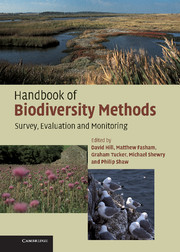Book contents
- Frontmatter
- Contents
- Preface
- Acknowledgements
- Part I Planning
- Part II Habitats
- Part III Species
- 9 Introduction to species assessment
- 10 General principles and methods for species
- 11 Fungi
- 12 Lichens
- 13 Bryophytes
- 14 Aquatic macrophytes and algae
- 15 Vascular plants
- 16 Dragonflies and damselflies
- 17 Butterflies
- 18 Moths
- 19 Other terrestrial invertebrates
- 20 Aquatic invertebrates
- 21 Fish
- 22 Amphibians
- 23 Reptiles
- 24 Birds
- 25 Bats
- 26 Other mammals
- Appendix 1 Monitoring and reporting obligations under international conservation agreements
- Appendix 2 Relationship between BAP Priority Habitat and Broad Habitat categories and Habitats Directive nomenclature
- Appendix 3 Annotated list of key references for plant identification
- Appendix 4 Determining appropriate quadrat size for vegetation sampling
- Appendix 5 The relocation of permanent plots
- Appendix 6 Equipment required for undertaking different types of survey
- Recommended sources of further information
- References
- Glossary
- Index
14 - Aquatic macrophytes and algae
Published online by Cambridge University Press: 01 September 2010
- Frontmatter
- Contents
- Preface
- Acknowledgements
- Part I Planning
- Part II Habitats
- Part III Species
- 9 Introduction to species assessment
- 10 General principles and methods for species
- 11 Fungi
- 12 Lichens
- 13 Bryophytes
- 14 Aquatic macrophytes and algae
- 15 Vascular plants
- 16 Dragonflies and damselflies
- 17 Butterflies
- 18 Moths
- 19 Other terrestrial invertebrates
- 20 Aquatic invertebrates
- 21 Fish
- 22 Amphibians
- 23 Reptiles
- 24 Birds
- 25 Bats
- 26 Other mammals
- Appendix 1 Monitoring and reporting obligations under international conservation agreements
- Appendix 2 Relationship between BAP Priority Habitat and Broad Habitat categories and Habitats Directive nomenclature
- Appendix 3 Annotated list of key references for plant identification
- Appendix 4 Determining appropriate quadrat size for vegetation sampling
- Appendix 5 The relocation of permanent plots
- Appendix 6 Equipment required for undertaking different types of survey
- Recommended sources of further information
- References
- Glossary
- Index
Summary
Aquatic macrophytes and algae can be divided into two relatively distinct groupings: (a) the microalgae, such as diatoms and most green and blue-green algae, which can only be seen, identified and counted with the aid of a microscope; and (b) those vascular plants and macroalgae that can be seen and assessed by the naked eye. Macroalgae include, in marine systems, the seaweeds and certain filamentous algae, and in freshwater systems the stoneworts (e.g. Chara and Nitella species) and filamentous algae (often lumped under headings such as ‘blanket weed’).
The methodology for surveying and sampling microalgae in their various forms, e.g. single-celled phytoplankton, diatoms growing on substrates and benthic mats, and in various habitats, e.g. freshwater, estuarine and marine systems, has been developed over the years and such methods are generally well described. This section provides an overview of some of the main aspects of the different techniques for surveying and monitoring aquatic microalgae; the reader needs to consult some of the recommended sources at the end of the book for further details or seek advice from an appropriate specialist. Different techniques are required for aquatic macrophytes; perhaps surprisingly, methods are still being developed to ensure that reliable surveying and sampling can be undertaken in a systematic and repeatable form.
Monitoring macrophytes in the aquatic environment presents some problems that have necessitated the development of techniques that are distinct from those used for monitoring terrestrial plants.
- Type
- Chapter
- Information
- Handbook of Biodiversity MethodsSurvey, Evaluation and Monitoring, pp. 295 - 302Publisher: Cambridge University PressPrint publication year: 2005



